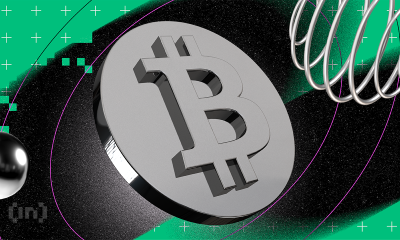Market
BTC Falls, BlackRock Eyes Blockchain, and More

This week, Bitcoin and the broader crypto market experienced a sharp decline following the release of US Consumer Price Index (CPI) data.
Speculation about BlackRock launching its own blockchain has also surfaced. Additionally, Binance’s delisting of several altcoins triggered significant market reactions.
Bitcoin’s “Fakeout” Following CPI Data Release
On August 14, the US Bureau of Labor Statistics (BLS) released July’s Consumer Price Index (CPI) data. The figure was lower than the previous month, leading to speculation that the Federal Reserve might cut rates in September, possibly by 25 basis points.
Bitcoin initially reacted positively to the data, trading above the $60,000 level. However, this proved to be short-lived, as the price quickly reversed, dropping below $60,000 — a move known in trading circles as a “fakeout.” At the time of writing, Bitcoin stands at $58,345, reflecting a 1.95% decrease in the past 24 hours.
Read more: Bitcoin (BTC) Price Prediction 2024/2025/2030
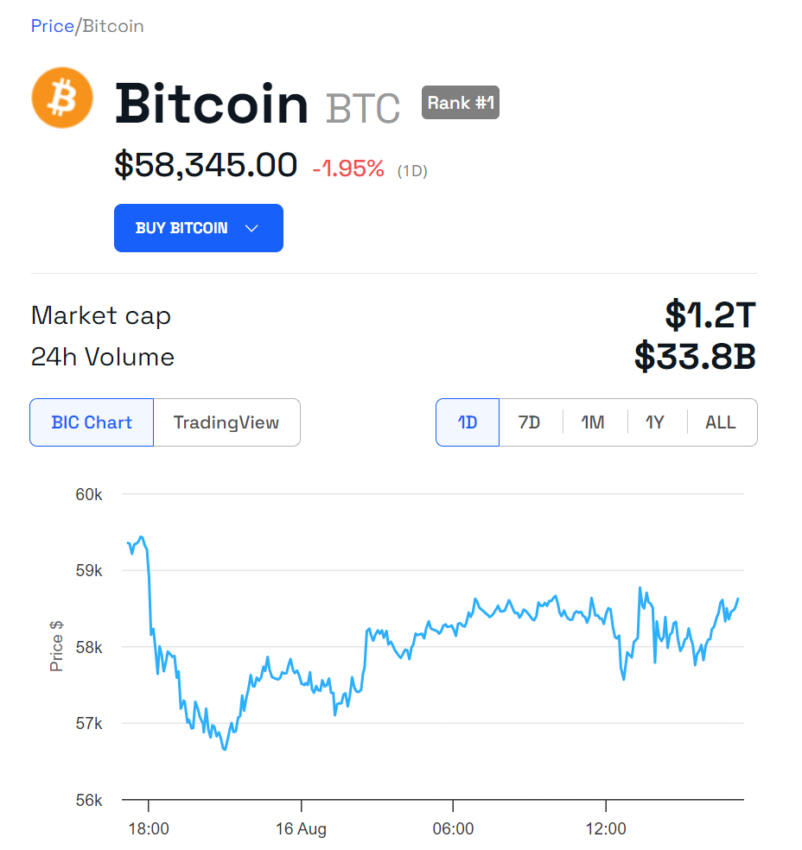
Despite this volatility, analysts maintain a positive long-term outlook for Bitcoin. Potential catalysts for a bullish trend include anticipated rate cuts, increased inflows into Bitcoin exchange-traded products (ETPs), and favorable regulatory developments.
Institutional Investors and Wall Street Giants Reveal Spot Crypto ETF Holdings
This week, institutional investors disclosed their positions in Bitcoin and Ethereum ETFs through their 13-F filings with the US Securities and Exchange Commission (SEC). Goldman Sachs, for example, holds positions in seven of the 11 available spot Bitcoin ETFs in the US. Its largest stake is in the iShares Bitcoin Trust (IBIT), with an investment valued at approximately $238.6 million.
In addition to IBIT, Goldman Sachs has invested heavily in other Bitcoin ETFs. Notably, the bank holds $79.5 million in Fidelity’s Bitcoin ETF (FBTC) and $56.1 million in the Invesco Galaxy Bitcoin ETF (BTCO), among others.
Similarly, Morgan Stanley, another Wall Street giant, also demonstrated a preference for BlackRock’s IBIT, with positions valued at $188 million. Furthermore, Morgan Stanley has smaller holdings in the Ark 21Shares Bitcoin ETF (ARKB) and the Grayscale Bitcoin Trust (GBTC).
The trading firm DRW Capital also presented its significant stake in crypto ETFs, particularly focusing on Ethereum. The company’s filings indicate an allocation of over $150 million to the Grayscale Ethereum Trust.
Additionally, the State of Wisconsin Investment Board (SWIB) reported owning nearly 2.9 million shares of BlackRock’s spot Bitcoin ETF (IBIT) as of June 30. This position, valued at nearly $99 million, marks a significant increase from the previous quarter, where SWIB held around 2.5 million shares. Interestingly, SWIB also reduced its exposure to the Grayscale Bitcoin Trust by offloading 1 million shares during the first quarter.
Vetle Lunde, a senior analyst at K33 Research, recently noted that the second quarter of 2024 saw a notable increase in institutional ownership of Bitcoin ETFs. The 13-F filings revealed that 1,199 professional firms held investments in US spot ETFs as of June 30. This number marks an increase of 262 firms from the previous quarter.
“While retail investors still hold the majority of the float, institutional investors increased their share of total AUM by 2.41 percentage points, now accounting for 21.15% in Q2,” Lunde remarked.
This growth in institutional participation is significant. It indicates that large financial entities are becoming more comfortable with the risk-reward profile of crypto investments.
Hydra Update Prepares Cardano for Chang Hard Fork
On August 9, Cardano released version 0.18.0 of its Hydra Head scaling solution. This upgrade is particularly crucial as Cardano prepares for its upcoming Chang hard fork, which aims to fully decentralize the blockchain.
Sebastian Nagel, a Cardano developer, emphasized that one of the key features of this update is the ability to withdraw funds from an open head without closing it. This improvement aligns with Cardano’s broader goal of transitioning into a decentralized network. Charles Hoskinson, Cardano’s founder, envisions it as a global system featuring advanced governance and community-driven initiatives.
Speculation Surrounding BlackRock’s Blockchain Initiative
According to a report by Token Terminal, BlackRock could be exploring the launch of a proprietary blockchain similar to Coinbase’s Layer-2 network, Base. The report suggests that such a blockchain could centralize the record-keeping of BlackRock’s vast holdings, enhancing transparency, efficiency, and security. If this plan materializes, it will align with BlackRock’s broader strategy of leveraging technology to streamline its operations and offer novel solutions to its clients.
However, such a project would have challenges, including managing the complex regulatory environment and ensuring the blockchain’s security and scalability. Despite BlackRock not confirming these plans and potential challenges, the asset management firm potentially launching a blockchain could represent a major shift in the traditional finance sector.
Six Altcoins Take a Hit After Binance Delisting Announcement
On August 12, Binance, the world’s largest crypto exchange by trading volume, announced the delisting of six altcoins. Effective August 26, 2024, at 03:00 UTC, Binance will remove all spot trading pairs for these tokens.
Historically, when Binance announces the listing or delisting of altcoins, it significantly impacts their prices. The recent delisting decision immediately caused the prices of the affected tokens to drop.
Read more: Which Are the Best Altcoins To Invest in August 2024?
The tokens impacted were PowerPool (CVP), Ellipsis (EPX), ForTube (FOR), Loom Network (LOOM), Reef (REEF), and VGX Token (VGX). Some of these even experienced value declines exceeding 20%.
Disclaimer
In adherence to the Trust Project guidelines, BeInCrypto is committed to unbiased, transparent reporting. This news article aims to provide accurate, timely information. However, readers are advised to verify facts independently and consult with a professional before making any decisions based on this content. Please note that our Terms and Conditions, Privacy Policy, and Disclaimers have been updated.
Market
Report Alleges Massive Meme Coin Sniping on Pump.fun

According to a new report from Pine Analytics, token deployers on Pump.fun systematically funded sniper wallets to buy their own meme coins. This impacted over 15,000 token launches on the platform.
These sniper wallets operated primarily during US trading hours, executing standardized, profitable strategies. Unrelated bot activity obscures their behavior, making it extremely difficult to isolate these wallets—and they can readily adapt to new countermeasures.
Snipers Roam Free on Pump.fun Meme Coins
Pump.fun has remained one of the most popular meme coin launchpads on Solana despite persistent controversies and other criticism.
However, Pine Analytics’ new report has uncovered a new controversy, discovering systematic market manipulation on the platform. These snipes include as much as 1.75% of all launch activity on Pump.fun.
“Our analysis reveals that this tactic is not rare or fringe — over the past month alone, more than 15,000 SOL in realized profit was extracted through this method, across 15,000+ launches involving 4,600+ sniper wallets and 10,400+ deployers. These wallets demonstrate unusually high success rates (87% of snipes were profitable), clean exits, and structured operational patterns,” it claimed.
Solana meme coin deployers on Pump.fun follow a consistent pattern. They fund one or more sniper wallets and grant them advance notice of upcoming token launches.
Those wallets purchase tokens in the very first block and then liquidate almost immediately—85% within five minutes and 90% in just one or two swap events.

Pump.fun meme coin developers exploit this tactic to create the appearance of immediate demand for their tokens. Retail investors, unaware of the prior sell‑off, often purchase these tokens after the snipe, giving developers an unfair advantage. This constitutes market manipulation and erodes trust in the platform.
Pine Analytics had to carefully calibrate its methods to identify genuine snipers. Apparently, 50% of meme coin launches on Pump.fun involve sniping, but most of this is probably bots using the “spray and pray” method.
However, by filtering out snipers with no direct links to developer wallets, the firm missed projects that covered their tracks through proxies and burners.
In other words, the meme coin community does not have adequate defenses against systematic abuse on Pump.fun. There are a few possible ways that the platform could flag repeat offenders and sketchy projects, but adaptive countermeasures could defeat them. This problem demands persistent and proactive action.
Unfortunately, it may be difficult to enact such policies. Meme coin sniping is so systematic that Pump.fun could only fight it with real commitment.
Analysts think that building an on-chain culture that rewards transparency over extraction is the best long-term solution. A shift like that would be truly seismic, and the meme coin sector might not survive it.
Disclaimer
In adherence to the Trust Project guidelines, BeInCrypto is committed to unbiased, transparent reporting. This news article aims to provide accurate, timely information. However, readers are advised to verify facts independently and consult with a professional before making any decisions based on this content. Please note that our Terms and Conditions, Privacy Policy, and Disclaimers have been updated.
Market
Solana Leads Blockchain Metrics as SOL Momentum Builds

Solana (SOL) continues to show strength across multiple fronts, maintaining a bullish structure on its Ichimoku Cloud chart while gaining momentum in key market metrics. The BBTrend indicator has turned higher again, signaling renewed buying pressure after a brief cooldown.
On-chain activity remains strong, with Solana leading all blockchains in DEX volume and dominating fee generation thanks to the explosive growth of meme coins and launchpad activity. With SOL now trading above a key resistance level, the path is open for further upside—though a loss of momentum could still trigger a retest of lower supports.
Solana Maintains Bullish Structure, but Momentum Faces Key Test
On Solana’s Ichimoku Cloud chart, the price is currently above the Kijun-sen (red base line) but has dipped below the Tenkan-sen (blue conversion line), signaling weakening short-term momentum.
The flattening Tenkan-sen and price behavior suggest possible consolidation or the early stages of a pullback. Still, with the price holding above the Kijun-sen, medium-term support remains intact.
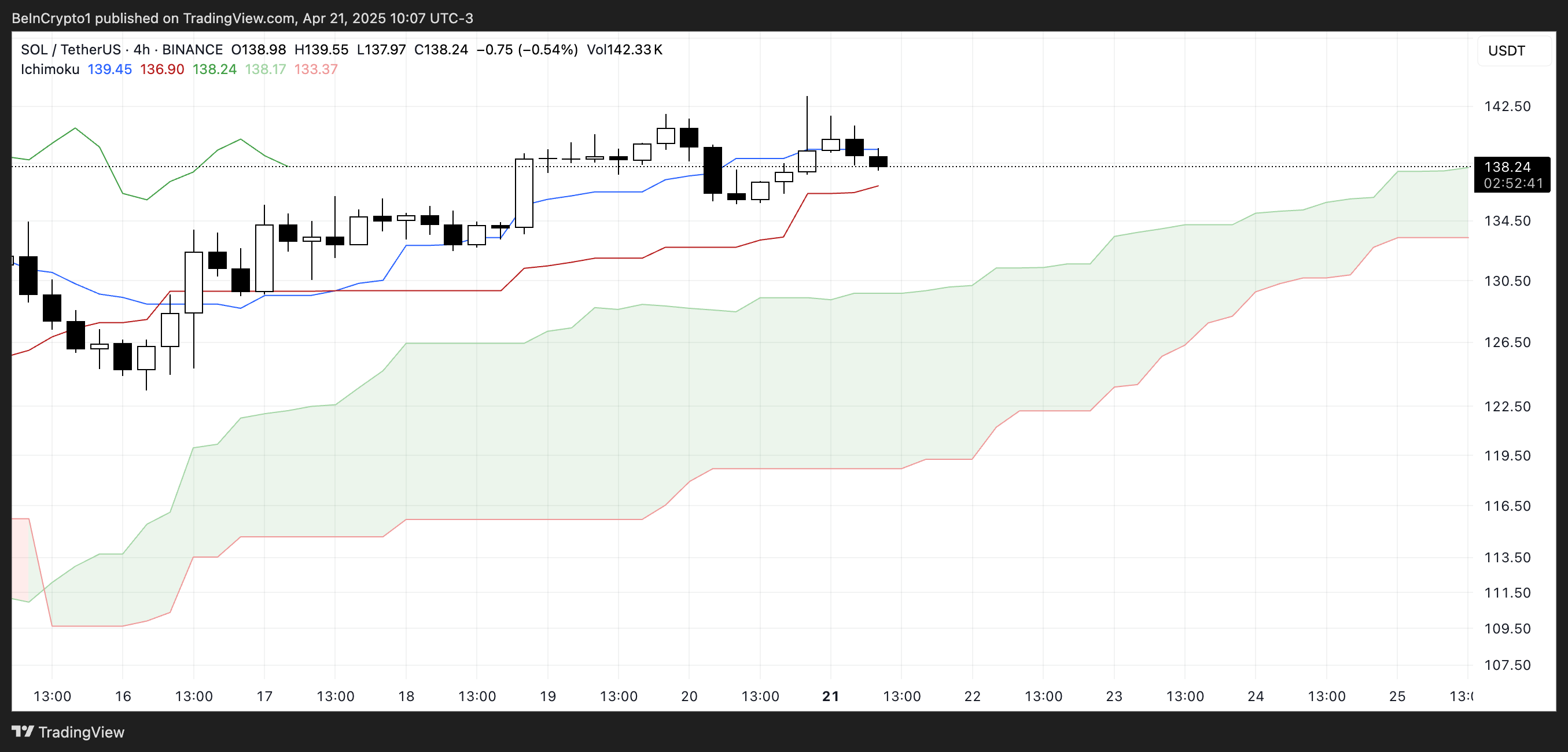
The overall Ichimoku structure remains bullish, with a thick, rising cloud and leading span A well above span B—indicating strong underlying support.
If Solana finds support at the Kijun-sen and climbs back above the Tenkan-sen, the uptrend could regain strength; otherwise, a test of the cloud’s upper boundary may follow.

Meanwhile, Solana’s BBTrend is currently at 6, extending nearly ten days in positive territory after peaking at 17.5 on April 14. The recent increase from 4.26 to 6 suggests renewed bullish momentum following a brief cooldown.
BBTrend, or Bollinger Band Trend, tracks the strength of price movement based on Bollinger Band expansion.
Positive values like the current one point to an active uptrend, and if the BBTrend continues to rise, it could signal stronger momentum and potential for another upward move.
Solana Dominates DEX Volume and Fee Generation as Meme Coins Drive Ecosystem Growth
Solana has once again claimed the top spot among all chains in DEX volume, recording $15.15 billion over the past seven days. The combined total of Ethereum, BNB, Base, and Arbitrum reached $22.7 billion.

In the last 24 hours alone, Solana saw $1.67 billion in volume, largely fueled by its booming meme coin ecosystem and the ongoing launchpad battle between PumpFun and Raydium. Adding to this good momentum, Solana recently surpassed Ethereum in Staking Market Cap.

When it comes to application fees, Solana’s momentum is just as clear. Four of the top ten fee-generating apps over the past week—PumpFun, Jupiter, Jito, and Meteora—are Solana-focused.
Pump leads the pack with nearly $18 million in fees alone.
Solana Breaks Key Resistance as Uptrend Targets Higher Levels, but Risks Remain
Solana has finally broken above its key resistance at $136, flipping it into a new support level that was successfully tested just yesterday.
Its EMA lines remain aligned in a bullish setup, suggesting the uptrend is still intact.
If this momentum continues, SOL price could aim for the next resistance zones at $147 and $152—levels that, if breached, open the door to a potential move toward $179.
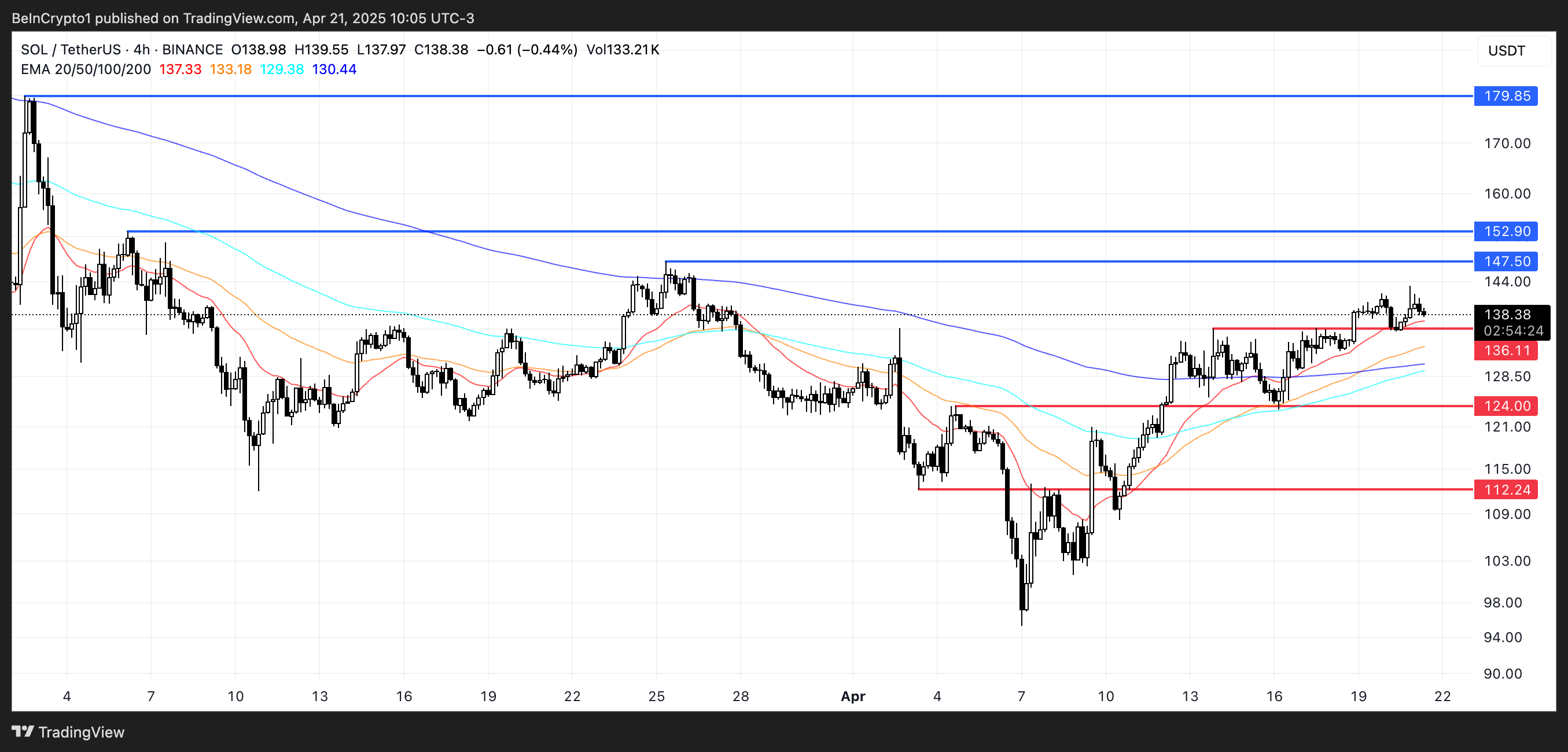
The current structure favors buyers, with higher lows and strong support reinforcing the trend.
However, if momentum fades, a retest of the $136 support is likely.
A breakdown below that level could shift sentiment, exposing Solana to deeper pullbacks toward $124 and even $112.
Disclaimer
In line with the Trust Project guidelines, this price analysis article is for informational purposes only and should not be considered financial or investment advice. BeInCrypto is committed to accurate, unbiased reporting, but market conditions are subject to change without notice. Always conduct your own research and consult with a professional before making any financial decisions. Please note that our Terms and Conditions, Privacy Policy, and Disclaimers have been updated.
Market
Crypto Firms Donated $85 million in Trump’s Inauguration
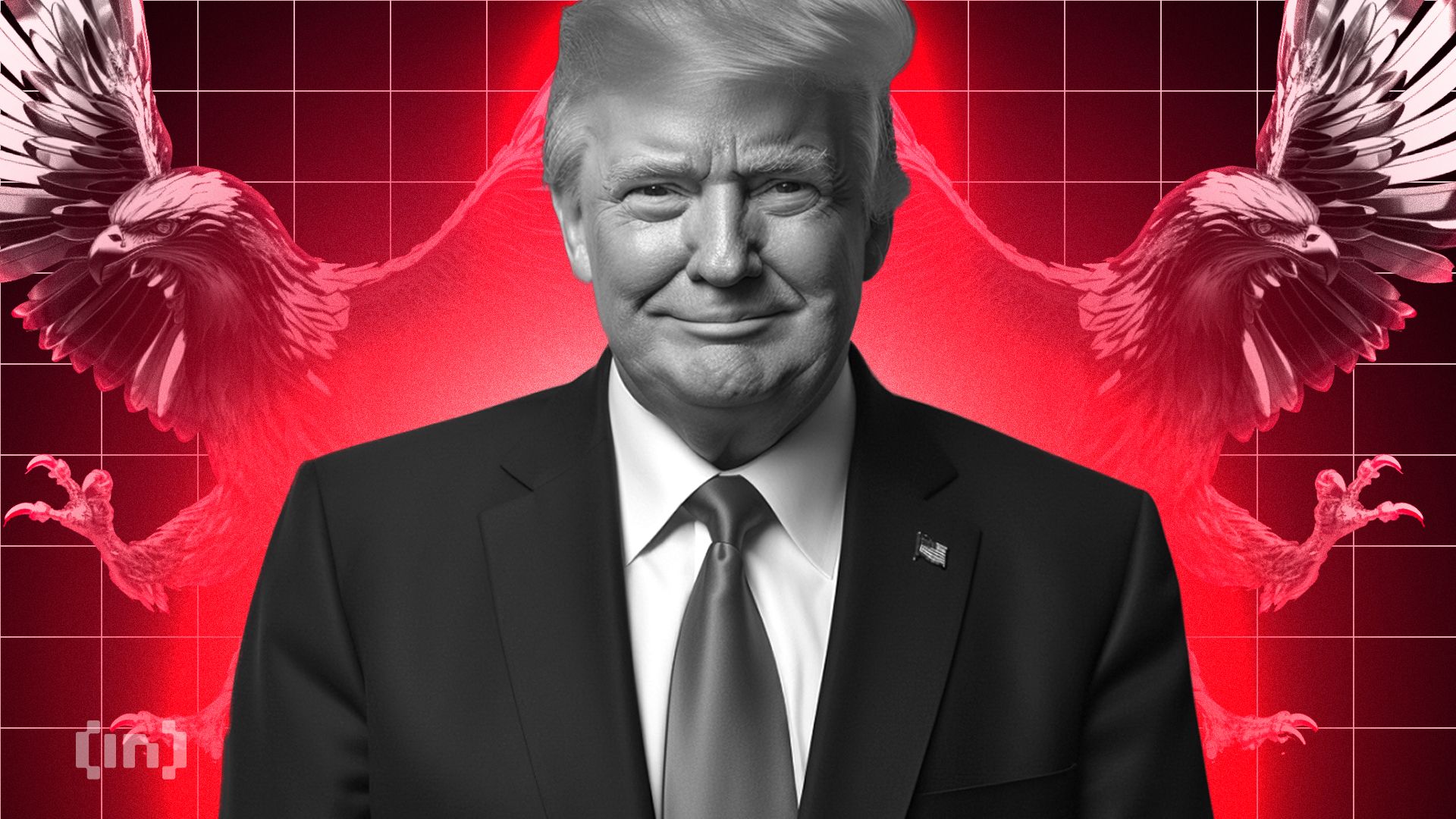
According to a new report, 15 firms and individuals from the crypto industry donated more than $100,000 to President Trump’s Inauguration, totaling over $85 million.
Almost all of these companies apparently received direct or indirect benefits from Trump’s administration. This includes dropped legal proceedings, lucrative business partnerships, participation in Trump’s Crypto Summit, and more.
Crypto Industry Went All-In on Trump’s Inauguration
Since promising to bring friendlier regulations on the campaign trail, Donald Trump attracted a reputation as the Crypto President.
Trump’s Inauguration festivities included a “Crypto Ball,” and several prominent firms made donations for these events. Today, a report has compiled all crypto-related contributions of over $100,000, revealing some interesting facts.

Since taking office, President Trump and his family have been allegedly involved in prominent crypto controversies, and these donations may be linked to several of them.
For example, eight of the donors, Coinbase, Crypto.com, Uniswap, Yuga Labs, Kraken, Ripple, Robinhood, and Consensys, had SEC investigations or lawsuits against them closed since Trump’s term began.
The commission might have dropped its probe against these companies anyway due to its changing stance on crypto enforcement. However, being in the President’s good books likely helped the process.
Further Alleged Benefits for Donors
In other words, nearly half the firms that made donations to Trump’s Inauguration have seen their legal problems cleared up quickly. This isn’t the only regulation-related benefit they allegedly received.
Circle, for example, recently made an IPO after openly stating that Trump’s Presidency made it possible. Galaxy Digital received SEC approval for a major reorganization, a key step for a NASDAQ listing.
Other donors, such as Crypto.com and ONDO, got more direct financial partnerships with businesses associated with the Trump family.
Previously, Ripple’s CEO, Brad Garlinghouse, anticipated a crypto bull market under Trump. Also, XRP, Solana, and Cardano were all unexpectedly included in the US Crypto Reserve announcement.
All three of these companies made major donations to Trump’s Inauguration.
It seems that most of the firms involved got at least some sort of noticeable benefit from these donations. Donors like Multicoin and Paradigm received invitations to Trump’s Crypto Summit, while much more prominent groups like the Ethereum Foundation got snubbed.
Meanwhile, various industry KOLs and community members have already alleged major corruption in Trump’s crypto connections.
While some allegations might lack substantial proof, the crypto space has changed dramatically under the new administration, for both good and bad.
Disclaimer
In adherence to the Trust Project guidelines, BeInCrypto is committed to unbiased, transparent reporting. This news article aims to provide accurate, timely information. However, readers are advised to verify facts independently and consult with a professional before making any decisions based on this content. Please note that our Terms and Conditions, Privacy Policy, and Disclaimers have been updated.








